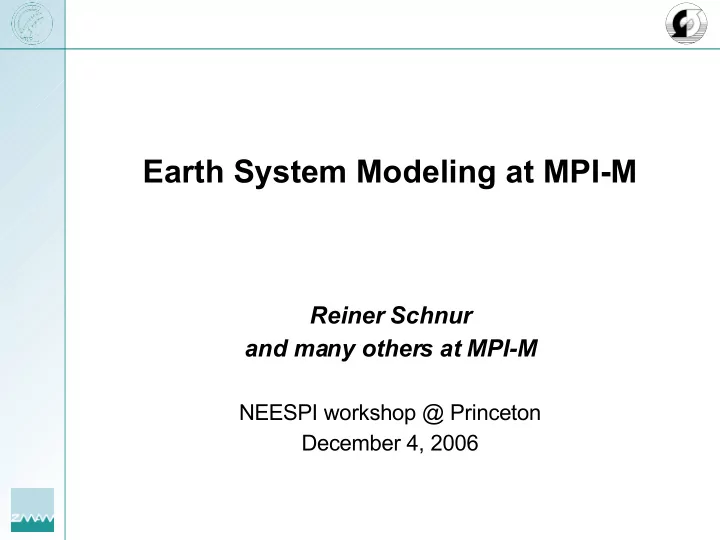

Earth System Modeling at MPI-M Reiner Schnur and many others at MPI-M NEESPI workshop @ Princeton December 4, 2006
MPI-ESM: Processes Sun Emissions Atmosphere Dynamics Aerosols Chemistry Land Surface Dust DMS CO 2 Momentum Hydrology Energy Photosynthesis Water Phenology Respiration Ocean Dynamics Sea-ice River runoff Biology Chemistry
MPI-ESM: Model Components Sun Emissions Atmosphere ECHAM HAM MOZART Dust DMS CO 2 JSBACH Land Momentum Energy Water PRISM coupler (OASIS) MPI-OM HAMOCC Ocean
MPI-ESM: IPCC AR4 experiments Sun ECHAM5 Specified concentrations (GHG, SO 4 ) T63L31 Momentum Energy ECHAM5 HD Water PRISM coupler (OASIS) MPI-OM 1.5°
MPI-ESM Ocean: Horizontal Resolution (Only every 5 th grid line drawn)
MPI-ESM: IPCC AR4 Model Comparison v s , 2 I m Overall Performance Index courtesy Thomas Reichler & Junsu Kim, Univ. of Utah A combined measure of how well 21 different global climate models simulate 35 different observed climate features (time averaged, large scale quantities). Avg. of 21 #1 #2 models = 1.0 Normalized so that the average model score = 1.0; Values less than 1.0 are better. Lower Values = Smaller GFDL CM2.1 MPI-ESM Errors (i.e., greater agreement btwn the model simulation & observations)
MPI-ESM: IPCC Experiments Incl. Carbon Cycle Sun Specified concentrations ECHAM (non-CO 2 GHG, SO 4 ) T63L31 CO 2 JSBACH / HD Momentum Energy Water PRISM coupler (OASIS) MPI-OM HAMOCC
MPI-ESM: Carbon Cycle Model (JSBACH) MPI-ESM: Carbon Cycle Model (JSBACH)
MPI-ESM: IPCC Experiments Incl. Carbon Cycle C4MIP experiments: Pre-industrial spinup run (286 ppm) Anthropogenic CO 2 emissions prescribed (1860-2000 as observed; 2001-2100 SRES A2) Feedback between carbon cycle and climate change calculated CO 2 used in radiation code climate changes No feedback pre-industrial CO 2 (286 ppm) used in radiation code no climate change The difference in carbon fluxes between the coupled and uncoupled runs represents the impact of global warming on the carbon cycle.
MPI-ESM: C4MIP Experiments Annual 2m temperature 1980s 1990s ocean land ocean land IPCC TAR 1.9 ± 0.6 1.9 ± 1.1 a 1.7 ± 0.5 3.0 ± 1.1 a Roedenbeck et al. (2003) b 1.8 ± 0.3 2.2 ± 0.9 2.3 ± 0.2 2.6 ± 0.9 climate – carbon cycle model c 1.96 ± 0.07 2.18 ± 0.25 2.24 ± 0.07 2.01 ± 0.25 Comparison of simulated carbon uptake [PgC/yr] for 1980-1989 and 1990-1999 in coupled run with estimates from IPCC and a recent inversion study
MPI-ESM: C4MIP Experiments Average monthly deviation from annual mean atmospheric CO2 concentration Anomalies of Nino3 SST (solid) and of carbon uptake rate (dashed) in coupled run observed simulated
MPI-ESM: C4MIP Experiments Carbon Uptake [GtC] GtC/year Carbon uptake coupled – uncoupled 1860-2100 kg C/m2 positive feedback negative feedback
Recommend
More recommend